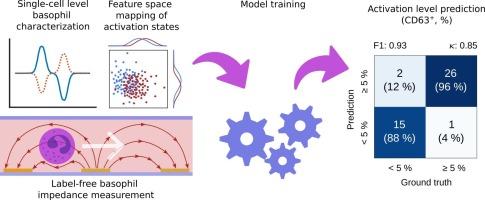Label-free, machine-learning assisted impedance assessment of basophil activation
IF 3.7
1区 化学
Q1 CHEMISTRY, ANALYTICAL
引用次数: 0
Abstract
Food allergies are increasing in prevalence, yet current diagnostic tests remain either inaccurate or potentially unsafe. The basophil activation test (BAT) has emerged as a promising functional assay, involving the ex vivo stimulation of whole blood with allergens and subsequent measurement of basophil activation. The BAT has been shown to have high diagnostic accuracy. However, clinical adoption of the BAT has been limited, in part due to logistical constraints, including the requirement for fresh blood and reliance on conventional flow cytometry analysis (FCA) of fluorescently labeled activation markers such as CD63 and CD203c. Despite recent advances in automation, FCA remains restricted to research and high-complexity clinical laboratories. Label-free, electronics-based sensing platforms have the potential to offer simpler operations and broaden the adoption of the BAT. In this study, we demonstrate the potential of label-free impedance flow cytometry (IFC) combined with machine learning for predicting basophil activation status. We measure impedance at six different frequencies (spanning 0.1 MHz to 24 MHz) in human basophils stimulated with different doses of stimulants from N = 15 anonymous donors. We compare IFC measurements with activation levels measured in FCA. By combining with machine learning models, we demonstrate strong correlation between IFC metrics and activation levels measured in FCA with Pearson correlation coefficient up to 0.89, and accurate classification of a positive or negative BAT result with a true positive rate (TPR) of 96% and a true negative rate (TNR) of 88%.

无标记、机器学习辅助的嗜碱性细胞活化阻抗评估
食物过敏的发病率正在上升,但目前的诊断测试要么不准确,要么可能不安全。嗜碱性粒细胞激活试验(BAT)已经成为一种很有前途的功能测定方法,包括用过敏原在体外刺激全血,然后测量嗜碱性粒细胞激活。BAT已被证明具有很高的诊断准确性。然而,BAT的临床应用一直受到限制,部分原因是由于后勤方面的限制,包括对新鲜血液的要求以及对CD63和CD203c等荧光标记激活标志物的传统流式细胞术分析(FCA)的依赖。尽管最近在自动化方面取得了进展,但FCA仍然局限于研究和高度复杂的临床实验室。无标签、基于电子的传感平台有可能提供更简单的操作,并扩大BAT的采用范围。在这项研究中,我们证明了无标记阻抗流式细胞术(IFC)结合机器学习预测嗜碱性粒细胞激活状态的潜力。我们测量了人类嗜碱性细胞在6个不同频率(0.1 MHz至24 MHz)的阻抗,这些细胞受到来自N = 15名匿名供体的不同剂量兴奋剂的刺激。我们比较了IFC测量值与FCA测量值的激活水平。通过结合机器学习模型,我们证明了IFC指标与FCA中测量的激活水平之间存在很强的相关性,Pearson相关系数高达0.89,并且对BAT阳性或阴性结果的准确分类,真阳性率(TPR)为96%,真阴性率(TNR)为88%。
本文章由计算机程序翻译,如有差异,请以英文原文为准。
求助全文
约1分钟内获得全文
求助全文
来源期刊

Sensors and Actuators B: Chemical
工程技术-电化学
CiteScore
14.60
自引率
11.90%
发文量
1776
审稿时长
3.2 months
期刊介绍:
Sensors & Actuators, B: Chemical is an international journal focused on the research and development of chemical transducers. It covers chemical sensors and biosensors, chemical actuators, and analytical microsystems. The journal is interdisciplinary, aiming to publish original works showcasing substantial advancements beyond the current state of the art in these fields, with practical applicability to solving meaningful analytical problems. Review articles are accepted by invitation from an Editor of the journal.
 求助内容:
求助内容: 应助结果提醒方式:
应助结果提醒方式:


